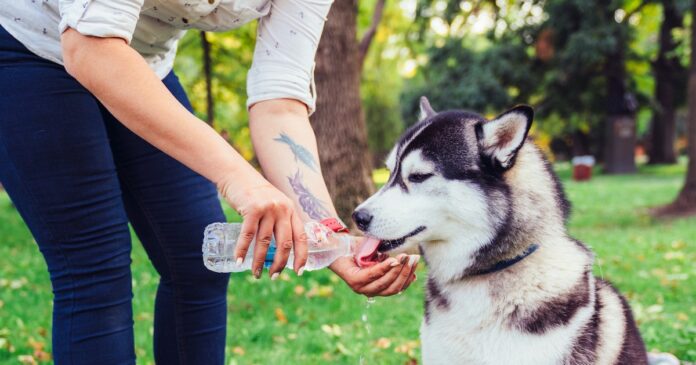Getting the entire household out of the home is among the best joys of summertime. Of course, the household canine absolutely enjoys attending to stretch their legs, too, and you may love attending to spend some high quality time together with your pup for additional walks, hikes, or playtime within the hotter months.
But our canine cannot inform us once they’ve had an excessive amount of, so staying alert for the warning indicators is essential whether or not your little ones are enjoying Frisbee together with your doggo otherwise you’re taking the entire gang out for a pleasant lengthy stroll.
So how are you aware what to search for? Two veterinarians gave Scary Mommy the total scoop.
What do you have to look ahead to?
When the climate is especially scorching and humid, you may wish to contemplate a number of components, together with your canine’s age, breed, and typical stage of exercise, as Don LeHoullier, DVM and proprietor of Countryside Veterinary Clinic, shares. “Animals with flat faces, like Pugs and Persian cats, are more susceptible to heat stroke because they can’t pant as effectively,” he explains.
You’ll additionally wish to stick with brief bursts of exercise for younger puppies and senior canine, in addition to canine of any age who aren’t used to common strenuous train. A brief neighborhood stroll or a couple of minutes of fetch outdoors is right for getting your pooch energetic with out overdoing it.
For canine of any age or breed, there are some surefire indicators they’re overheating or overtired, says LeHoullier. “Excessive panting or difficulty breathing, increased heart and respiratory rate, drooling, mild weakness, and vomiting are all warning signs.”
“They might also show signs of confusion or disorientation or may be unable to stand or walk properly,” provides Dr. Lindsay Butzer, DVM, and PetMeds companion. “In extreme cases, they might even collapse.”
Obviously, you may wish to keep away from getting your pup thus far within the first place, so how are you aware if the climate circumstances are secure for your loved one fur baby?
“In the hot summer months, it’s best to exercise your dog in the early morning or late evening when temperatures are cooler,” says Butzer. “Dogs can be at risk of heat stroke at temperatures as low as 70F,” provides LeHoullier. “As you exercise your dog, you will get to know their tolerance for exercise during various weather conditions. Start slow, and don’t overdo it. This is where routine visits to your family veterinarian are important. This will allow you to understand the uniqueness of your dog as well as be aware of any underlying health conditions.”
Why do canine pant, anyway?
“Dogs are not able to sweat like humans do,” says LeHoullier. “Panting allows an alternate method for cooling the body. While panting, the dog moves hot air over the moist mucous membranes of the mouth and respiratory tract. This evaporates the moisture, removing heat from the body and cooling the dog. The normal respiratory rate of a dog is ten-to-thirty breaths per minute and, when panting, can reach over two hundred breaths per minute.”
Not certain in case your pet’s panting is trigger for concern? “Panting should correlate with the ambient temperature and/or the level of activity,” he provides. “Stress, excitement, and pain can also lead to panting. If the breathing or panting is irregular, has an abnormal sound, or the mucous membranes are not a normal color (i.e., purple or pale instead of pink), this would be a cause for concern, and your veterinarian should be called.”
Staying Safe All Summer Long
No matter the climate, there are a number of methods you possibly can guarantee your canine’s security within the nice outdoor, wherever your adventures could take you.
“Always bring water for both you and your dog, and avoid hot surfaces like asphalt that can burn their paws,” says Butzer. “Offer them water to drink, and if possible, wet their body with cool (not cold) water. Avoid submerging them in cold water as this can cause shock.” LeHoullier recommends providing cool, recent water in small quantities, encouraging them to decelerate if they’re drinking too much, too fast.
While it would really feel instinctive to wrap your pup in a chilly, damp towel, LeHoullier says you must completely not do that. “Never cover a dog with a wet towel to cool them off,” he explains. “This actually traps heat close to their body. “If sufficient water is obtainable, it may also be used to dampen the canine’s fur.”
“If you are removed from house and wish to chill your canine off, attempt to discover a shady spot and encourage them to relaxation,” says Butzer. You’ll want to cease activity immediately, and getting them to a building or car with air conditioning is ideal, says LeHoullier.
Swimming is also a great way to get them some exercise without worrying about overheating, but you’ll want to keep an eye on your pup the same way you keep an eye on your kids. And if it’s just too hot or stormy to step outside, Butzer says, “Indoors, you possibly can play video games like disguise and search, use puzzle toys to maintain them mentally stimulated, or arrange an indoor impediment course.”
The TL;DR
“Remember, each canine is totally different, and what works for one may not work for one more,” says Butzer. “It’s at all times finest to seek the advice of together with your vet about your canine’s particular train wants and hold them secure in scorching climate.”
Keeping up on your pet’s veterinary care year-round will help you stay on top of any potential health concerns, adds LeHoullier. Of course, any time you notice something concerning with your furry pals — during exercise or otherwise — checking in with your vet is never a bad idea. It’s always better to err on the side of caution, especially when it comes to the health and well-being of your furriest family members.



